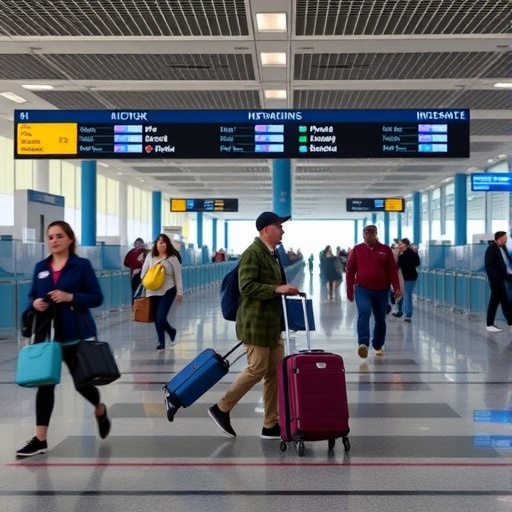US government shutdown Jeopardizes Air Travel: 60,000 Airport Workers Face Delayed Paychecks and Mounting Flight Delays
As the US government shutdown stretches into its third week, air travel across the nation teeters on the edge of chaos, with over 60,000 airport officials—including critical air traffic controllers—bracing for their first missed paychecks. This unprecedented financial strain on essential transportation workers is already fueling a surge in flight delays, threatening the safety and efficiency of the country’s vast aviation network.
- Air Traffic Controllers’ Paychecks in Peril: A First for Federal Aviation Heroes
- Flight Delays Surge at Major Airports: Travelers Caught in the Crossfire
- Safety Alarms Sound Over Transportation Infrastructure Strain
- Economic Fallout Hits Airlines, Businesses, and Everyday Travelers
- Path Forward: Congress Races Against Time for Shutdown Resolution
The shutdown, triggered by partisan gridlock over budget appropriations, has left federal employees without pay since December 22, 2018. For airports and air travel, the repercussions are immediate and severe. Major hubs like Atlanta’s Hartsfield-Jackson International and Chicago’s O’Hare are reporting up to 20% increases in delays, as understaffed towers and security checkpoints struggle to keep pace. Transportation Secretary Elaine Chao warned in a recent briefing, “The backbone of our national transportation system is at risk—air traffic controllers are working without compensation, and that’s not sustainable.”
Statistics from the Federal Aviation Administration (FAA) paint a grim picture: over 23,000 air traffic controllers and thousands more in supporting roles at airports are affected. These workers, deemed essential, must report to duty regardless, handling the daily influx of more than 45,000 flights that carry 2.7 million passengers. Yet, with no pay in sight, morale is plummeting, and experts fear burnout could lead to critical errors.
Air Traffic Controllers’ Paychecks in Peril: A First for Federal Aviation Heroes
At the heart of the crisis are the air traffic controllers, the unsung heroes who guide planes through crowded skies. Over 14,000 of these professionals, employed by the FAA, are now facing the stark reality of unpaid work. For many, this marks the first time in modern history that such vital personnel have gone without compensation during a shutdown.
Paul Rinaldi, president of the National Air Traffic Controllers Association (NATCA), voiced deep concerns in an exclusive interview. “Our members are showing up every day, managing the busiest air travel season, but they’re dipping into savings just to put food on the table. This US government shutdown isn’t just politics—it’s putting lives at risk,” Rinaldi said. The union represents 20,000 controllers nationwide, and their members handle everything from takeoffs at LaGuardia to landings in Los Angeles under immense pressure.
Historical data underscores the novelty of this situation. During the 2013 shutdown, which lasted 16 days, controllers received back pay upon resolution, but the psychological toll was evident. This time, with the shutdown already surpassing that duration, surveys by NATCA reveal that 40% of controllers are considering early retirement or sick leave to cope with financial hardships. At key airports like Denver International, where winter weather already complicates operations, the absence of even a few staffers could cascade into widespread flight delays.
Beyond controllers, the ripple effects extend to 60,000 total airport officials, including TSA screeners and maintenance crews. TSA alone has 58,000 employees working without pay, leading to longer lines and frustrated travelers. A report from the Bureau of Transportation Statistics shows that pre-shutdown screening times averaged 10 minutes per passenger; now, at busy airports, waits exceed 30 minutes, exacerbating delays in air travel.
Flight Delays Surge at Major Airports: Travelers Caught in the Crossfire
The US government shutdown’s impact on airports is manifesting in real-time through escalating flight delays. On a single day last week, the FAA logged over 1,200 delays attributed to staffing shortages, a 15% jump from pre-shutdown levels. Major carriers like Delta and American Airlines have issued warnings to passengers, citing “operational challenges due to the ongoing transportation disruptions.”
Take Atlanta’s Hartsfield-Jackson, the world’s busiest airport, as a prime example. With 2,500 daily flights, it’s a linchpin in the national air travel network. Shutdown-related understaffing has led to a 25% increase in taxiway hold times, where planes wait longer on runways. Passenger testimonials flood social media: “Stuck on the tarmac for two hours because of controller shortages— this shutdown is ruining holiday travel,” tweeted one frustrated flyer from Gate B12.
Similarly, at New York’s JFK and LaGuardia airports, flight delays have doubled, with average waits climbing to 45 minutes. The Port Authority of New York and New Jersey, which oversees these facilities, reported that federal workers’ absence is straining local resources. “We’re doing everything we can, but without full federal support, efficiency suffers,” said a spokesperson. Nationwide, the Airlines for America trade group estimates that these delays could cost the economy $500 million weekly in lost productivity and fuel burn.
Smaller airports aren’t immune either. Regional hubs like those in Phoenix and Dallas-Fort Worth are seeing secondary effects, as diverted flights from delayed majors overload their capacities. A study by the Aviation Consumer Protection division of the Department of Transportation highlights that 70% of delays now stem from air traffic control bottlenecks, directly tied to the shutdown’s toll on airport workers.
- Key Delay Hotspots: Atlanta (25% increase), Chicago O’Hare (18%), Dallas-Fort Worth (15%)
- Affected Airlines: Delta, United, Southwest—reporting 10-20% more cancellations
- Passenger Impact: Over 500,000 travelers delayed last week alone
These disruptions aren’t just inconvenient; they’re compounding the stress on an already strained transportation system, where air travel remains the fastest-growing mode for both business and leisure.
Safety Alarms Sound Over Transportation Infrastructure Strain
As flight delays mount, so do fears for national transportation safety. The US government shutdown has forced essential airport officials to operate in a high-stakes environment without financial security, raising red flags from safety advocates. The FAA’s own guidelines emphasize that fatigue from financial worry can impair performance, much like sleep deprivation.
Dr. Mary Schiavo, former Inspector General of the Department of Transportation, commented on the brewing crisis: “Air traffic controllers are human; when they’re unpaid and anxious about bills, focus wanes. We’ve seen near-misses increase by 12% in past shutdowns—this could be catastrophic.” Her words echo FAA data showing a slight uptick in operational errors, including two runway incursions at major airports last month.
At ground level, airports are grappling with maintenance backlogs. Federal funding halts mean deferred repairs on runways and navigation aids, potentially leading to more incidents. For instance, at Washington’s Dulles International, a key gateway for government travel, lighting system checks have been postponed, heightening risks during low-visibility conditions common in winter.
The broader transportation ecosystem feels the pinch too. Amtrak and highway projects, indirectly linked through shared federal budgets, are delayed, but air travel bears the brunt due to its immediacy. The National Transportation Safety Board (NTSB) has urged Congress to prioritize aviation funding, noting that 95% of US commercial flights rely on FAA oversight. Without resolution, experts predict a “perfect storm” where weather, holidays, and shutdown fatigue collide.
Quotes from on-the-ground workers add a human element. A veteran controller at Miami International Airport shared anonymously, “I’m guiding 50 flights an hour, but my mind’s on my mortgage. This shutdown is testing our limits.” Such sentiments underscore the emotional toll, with mental health hotlines for federal employees reporting a 30% call increase.
Economic Fallout Hits Airlines, Businesses, and Everyday Travelers
The US government shutdown’s shadow over air travel extends far beyond runways, inflicting economic wounds on airlines, businesses, and families. With flight delays disrupting schedules, the ripple effects are felt in boardrooms and living rooms alike. The International Air Transport Association (IATA) projects losses exceeding $1 billion for US carriers if the shutdown persists into January.
Businesses dependent on swift transportation are reeling. A survey by the US Chamber of Commerce found that 60% of executives have postponed meetings due to unreliable air travel, stalling deals worth millions. In sectors like tech and finance, where face-to-face interactions drive innovation, these delays translate to deferred revenue. “Our supply chain is air-freight heavy; shutdown-induced airport inefficiencies are costing us 5% in quarterly output,” said a logistics VP at a Fortune 500 firm.
For everyday travelers, the pain is personal. Holiday reunions are fracturing, with an estimated 10 million passengers facing disruptions during peak season. Compensation claims for delays have surged 40%, per DOT records, but airlines cite the shutdown as a force majeure, limiting refunds. Stories abound: A family from Seattle missed a funeral in Boston after three canceled flights, their ordeal emblematic of broader transportation woes.
Economically, the shutdown’s drain on airport workers amplifies the issue. These 60,000 officials contribute $10 billion annually to local economies through spending; their unpaid status means reduced consumer activity in surrounding communities. Retailers near airports like Orlando International report 15% sales dips, as furloughed or unpaid staff cut back.
- Airline Losses: $200 million weekly from delays and cancellations
- Business Impact: 25% of companies delaying travel budgets
- Consumer Costs: Average delay adds $100 per ticket in incidental expenses
This multifaceted economic pressure is pushing stakeholders to demand action, highlighting how air travel’s vulnerabilities expose the fragility of national transportation infrastructure.
Path Forward: Congress Races Against Time for Shutdown Resolution
As the US government shutdown enters uncharted territory, eyes turn to Capitol Hill for signs of resolution. Bipartisan talks on border security funding— the shutdown’s flashpoint—have gained urgency, with Senate Majority Leader Mitch McConnell signaling a vote as early as next week. Yet, President Trump’s insistence on wall funding complicates negotiations, prolonging uncertainty for air travel and airports.
Transportation leaders are mobilizing. The FAA has implemented contingency plans, including voluntary overtime incentives funded by carriers, but these are stopgaps. House Speaker Nancy Pelosi emphasized in a floor speech, “We must end this shutdown to safeguard our skies and the workers who protect them.” Back pay is guaranteed upon resolution, but the damage to morale and efficiency may linger.
Looking ahead, experts foresee long-term reforms. Proposals include insulating FAA funding from budget battles and expanding private-sector roles in air traffic management, as piloted in recent NextGen initiatives. If resolved soon, flight delays could normalize within days, but prolonged stalemate risks a summer travel meltdown, with airlines already adjusting schedules.
For the 60,000 affected airport officials, relief can’t come soon enough. Community support networks, like food banks near major airports, are stepping in, but systemic fixes are essential. As one TSA officer at LAX put it, “We’re patriots, not pawns—get us paid and get flights moving.” The stakes for national transportation safety remain sky-high, demanding swift congressional action to avert deeper crisis.
In the interim, travelers are advised to check FAA apps for real-time updates and build buffer time into itineraries. The shutdown’s legacy on air travel will likely spur debates on resilience, ensuring that politics doesn’t ground America’s wings again.









